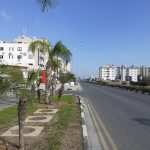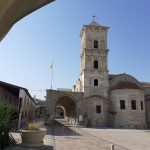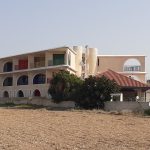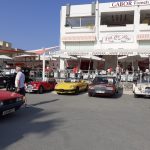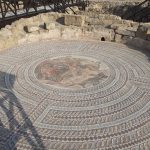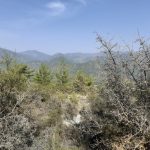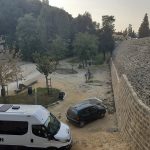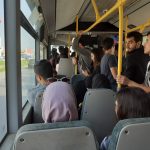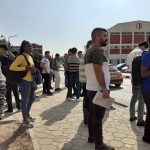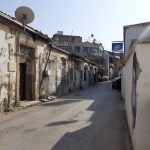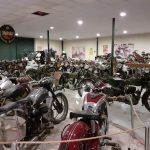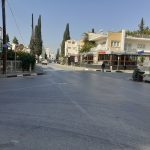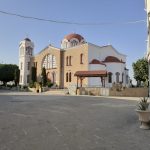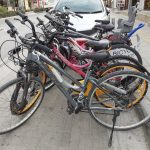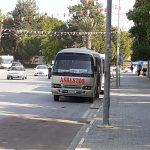Cyprus 2019
CLICK ON PICTURES TO ENLARGE
CYPRUS 2019
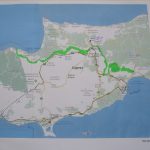 Why Cyprus? Well, I was looking for somewhere to go in November that would be warm, not too far, be politically interesting and, of course, have some classic cars. In general I have never been very attracted by the Mediterranean, but this time Cyprus seemed to fill the bill.
Why Cyprus? Well, I was looking for somewhere to go in November that would be warm, not too far, be politically interesting and, of course, have some classic cars. In general I have never been very attracted by the Mediterranean, but this time Cyprus seemed to fill the bill.
Situated between Turkey and Greece, the population has long been made up mainly of people from those countries and for many decades up to 1878 the island was part of the Ottoman empire. In 1878 Turkey and Britain signed an agreement whereby Turkey would retain sovereignty but ceded the administration to Britain, who wanted a military presence in the area. In due course Britain took complete control until the 1950s, when the British came under attack from EOKA, a Greek nationalist group. This was followed by serious friction between the Greek and Turkish communities and in 1960 the independent Republic of Cyprus was created, with Britain retaining a few small areas for military purposes.
Political instability continued and in 1964 the UN sent a peacekeeping force led by a British general who drew a line with a green pen marking the division between the Greek and Turkish occupied areas of Nicosia which eventually spread across the whole country and became known as the ‘Green Line’.
The unrest continued with some American involvement until in 1974 Turkish forces invaded from the north and the Greek and Turkish populations became ever more divided. The UN has been in the area ever since, and a political settlement still seems to be a long way away. The Greek occupied area south of the Green Line is internationally recognised as the Republic of Cyprus, is a member of the EU and uses the euro as its currency. The Turkish area north of the line calls itself the Turkish Republic of North Cyprus and is only recognised as an independent state by Turkey. Its currency is the Turkish Lira. .Since 2003 it has been possible to go through the green line in both directions and many people do.
This is a very sketchy description of a complicated situation and more detailed accounts can be found in the Lonely Planet Guide to Cyprus and the Bradt Guide to North Cyprus.
I remember the partition of Cyprus very well. In England at the time I had a girl friend named Dinah whose parents had died and left her a house. She had enjoyed several holidays in Cyprus, and sold the house in England with a view to buying one in Cyprus. She asked my advice and I told her it was risky, but she never took my advice anyway. Her pen was practically paused in mid-air over the contract when the Turks invaded, and in a rare flash of common sense she changed her mind and decided not to sign away her inheritance.
Language
As might be expected, Greek is the main language south of the Green Line, and Turkish is generally used in the north, while English is widely spoken everywhere, although I did have some difficulty in the north (see later). When translated into Latin (English) characters many places have 2 or 3 names. For example the capital is known as Nicosia in English, Lefcosia in Greek and Lefcoșa in Turkish. If you drive over the mountains from Paphos to Nicosia most if not all of the road signs only refer to it as Lefcosia, so it is important to know these differences. Place names on road signs and maps will also be in Greek characters in the south and have some Turkish characters in the north, so the situation is quite complicated. It can be difficult to put place names into a British satnav.
Larnaca (Larnaka, ΛΑΡΝΑΚΑ)
There are direct flights with easyJet taking about five hours from Gatwick to Larnaca, on the south east coast of Cyprus. Everything went well and the Fiat Tipo was ready for me at Budget Car Rental. I had booked for two nights at the Elysso Hotel, which is on the north side of the town about five miles from the airport and the satnav led me in the dark straight to the hotel, which was in its database. This was fortunate, because none of the surrounding street names were. A relic of the British occupation is that traffic drives on the left.
The hotel did not have a restaurant other than for breakfast, but recommended one round the corner. The meal, although it was too big for me and not greatly to my taste, provided me with the necessary sustenance as I had not eaten since mid-day.
My second-floor room was overlooking an urban duel carriageway with traffic lights in one direction and a roundabout in the other, with a 50kph (31mph) speed limit. For two or three hours it seemed to serve as a sprint course for fast cars and motorcycles, some of which must have been doing 90mph (I am not joking) as they went past my room. The noise was tremendous and the police must be aware of what goes on, but I think they just let the boys have their fun for a couple of hours in the evening when there was not much traffic.
Although the hotel had an underground car park they suggested that it would be easier if I left the car on an area of waste ground opposite which already had several vehicles on it. They assured me that it would be safe and that proved to be the case. In fact, I came to realise that, as the guide books said, Cyprus is in most respects a very safe country. The highest risk is probably in driving, and although worse than Britain it is far better than in many countries I have been to.
The overall plan now was to have an easy day in Larnaca and then spend six days on a more or less circular route, driving along the coast to Paphos, over the mountains to Nicosia and back to Larnaca..
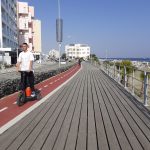 The next morning I drove most of the way along the sea front, parked near the Fishing Shelter and walked down to Mackenzie Beach at the far end of the built-up area. The weather was just perfect, clear blue sky, warm but not too hot. There were few people around and next to the road was a cycle track on which youths were tearing along on electric scooters and fat wheeled bicycles of the type that are not allowed in public places in England. I immediately decided that I wanted one, and asked the youths where I could hire one. They directed to me a place that I would pass as I walked into the town and when I found it the man in charge said there were no bikes available until 2pm because the youths had run the batteries down!
The next morning I drove most of the way along the sea front, parked near the Fishing Shelter and walked down to Mackenzie Beach at the far end of the built-up area. The weather was just perfect, clear blue sky, warm but not too hot. There were few people around and next to the road was a cycle track on which youths were tearing along on electric scooters and fat wheeled bicycles of the type that are not allowed in public places in England. I immediately decided that I wanted one, and asked the youths where I could hire one. They directed to me a place that I would pass as I walked into the town and when I found it the man in charge said there were no bikes available until 2pm because the youths had run the batteries down!
On the way into town I passed a small general store with a window full of English magazines and newspapers, so there must be a considerable British presence in the area. At 11.00am the newspapers had that day’s date, so they must be printed in that part of the world, something that is easily done with modern technology. The prices were about double those in England which made the Daily Telegraph £4, so I decided that I could make do with my tablet and the hotel wifi later on.
After some distance I came to the castle and the start of the main beach area. The town centre was set back some way from the beach and had a number of attractive stone buildings, including the dominant St. Lazarus Church and a mosque. This was basically the old town with a selection of small shops, the big stores and supermarkets being further out as is usual nowadays. Facing the next stretch of beach with palm trees was a long line of restaurants and takeaways including McDonald’s, Burger King and many more upmarket establishments. A wide strip of the beach was effectively private and covered with loungers and sunshades, but there was a public area between that the sea.
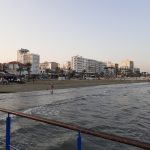 At the north end of the beach was a wooden fishing pier and marina. Beyond that is the commercial harbour and there is no further access to the beach for a considerable distance.
At the north end of the beach was a wooden fishing pier and marina. Beyond that is the commercial harbour and there is no further access to the beach for a considerable distance.
The town was not at all crowded and a high proportion of the people around were British. The weather was really beautiful, and I could understand why people retire to a place like that, although I think I would get bored fairly quickly. No doubt there is a thriving British community and I am sure it is great if you like playing card games. Of course, the weather is not always perfect, and from November onwards there is a lot of rain at times.
After a wander round the town I made my way back to the car. It was later than I expected, so I decided to leave the electric bike until the next week when I would have some more time in Larnaca.
Limassol (Lemesos, ΛΕΜΕΣΟΣ)
The next morning I followed the coast road to the airport, stopping to look at the Salt Lake, with its large population of birds. There are supposed to be flamingos, but I didn’t see any. It was my intention to take the coast road to Limassol but after messing around at the back of the airport I could not find it and took the motorway instead.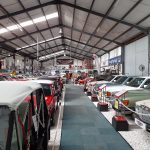
The main purpose of going to Limassol was to visit the Cyprus Historic and Classic Motor Museum, which was easily reached without going into the town. The museum is privately owned and contains about 150 vehicles, from the obligatory 1886 Benz replica through to 2004 and includes cars used by famous people such as President Makarios lll, Mrs.Thatcher and Mr.Bean. For the enthusiast it is a good varied collection and worth visiting.
Close to Limassol is the British Sovereign Base at Akrotiri which was frequently mentioned on the radio in the days of ‘Family Favourites’ and similar programmes for British forces overseas.
After leaving the museum I found myself in Episkopi, another name from the past which is like a little bit of England with housing estates and other facilities for the forces.
Paphos (Pafos, ΠΑΦΟΣ)
The motorway from there to Paphos was quite mountainous in places, with good scenery. I did not have a hotel reserved in Paphos and started looking for one when I arrived at 4.00pm. In November I thought it would be easy to find accommodation, but the first hotel I tried was full and the second was closed for the winter. I drove right through the town to the beach area and very quickly found the Pandream Hotel Apartments about 100 yards from the beach for £37 a night. It was quite a large Spanish-style place with only a handful of guests and I had a big second floor room with a sea view from the balcony.
The Tea for Two restaurant was separate on land adjacent to the beach, and as I walked down it inthe morning I saw a very smart 1950s Vauxhall go past. When I turned the corner I was surprised to see that the restaurant car park was full of classic cars, and it transpired that it was the monthly breakfast meeting of the Paphos Classic Vehicle Club. There were at least 30 people, mostly retired couples, and there is obviously a large ex-pat community in the area. After breakfast I set off along the beach and almost everyone around was British.
In the summer Paphos is a popular resort and am told that it is very hectic, but in November, even with the beautiful weather, it was not at all crowded.
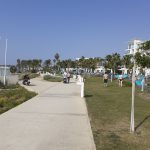 A path called the Coastal Broadwalk runs along the sea front past the town centre, the marina and the archaeological site entrance, right to the castle at the end, a distance of about two miles from my apartment. In the marina was a strange vessel, obviously based on Jules Verne’s Nauilus submarine. Upon further investigation it proved to be an eight-seater 7D cinema, but unfortunately was closed. How the 7D works I cannot imagine.
A path called the Coastal Broadwalk runs along the sea front past the town centre, the marina and the archaeological site entrance, right to the castle at the end, a distance of about two miles from my apartment. In the marina was a strange vessel, obviously based on Jules Verne’s Nauilus submarine. Upon further investigation it proved to be an eight-seater 7D cinema, but unfortunately was closed. How the 7D works I cannot imagine.
Nearby was the entrance to the archaeological site, which caused me to have a rare and brief attack of culture. It covers a considerable area of ground and is still being explored.
It dates from the 4th century BC and houses the famous Pafos mosaics, which I had actually never heard of. The mosaics tell the stories based on ancient Greek myths, which are explained in Greek and English on information boards. Some of them are inside buildings and some out in the open. One thing I liked was that they had incorporated some odd small areas of mosaic into the concrete paths so that you could actually walk on them.
The day seemed to pass very quickly and finished with a meal at the Tea for Two restaurant.
Over the Troödos Massif to Nicosia
The next morning I set off to drive over the mountains to Nicosia. At 1952m (6404ft) the highest mountain in Cyprus is Mount Olympus, which is roughly half way between Paphos and Nicosia, and stands in the middle of a range called the Troödos Massif.
The roads in the area are very complicated, and looking at the map I decided to aim for a place called Pano Platres, which was recognised by my satnav. The route retraced my steps on the motorway towards Limassol for some distance before turning off onto the mountains. Then followed about 25 miles of beautiful scenery with a long climb up to Pano Platres, after which I got hopelessly lost, despite all my GPS equipment. I still don’t understand how it happened, but there were a vast number of small roads with tourist signs and nothing that I could recognise on the map or put into the satnav.
It was considerably cooler than on the coast, and there were signs to ski resorts, although it was nothing like cold enough for that. Eventually I got on to the main road B8 which goes close to the summit of Mount Olympus before dropping downhill (as the B9) in the direction of Nicosia. From Paphos to Nicosia is 148km (92miles) via the motorway, but my mountain route took far longer than that, and I finally got to the outskirts of Nicosia at about 3pm.
Nicosia (Greek side: Lefcosia, ΛΕΥΚΟΣΙΑ. Turkish side: Lefkoșa)
The hotel that I had booked was right in the old city, in the centre, and I did not realise how difficult it would be to get there on a Sunday afternoon. The narrow streets were packed with people and it was sheer driving hell getting to the hotel, reminiscent of Istanbul and towns in India. The hotel was supposed to have a car park, but when I got to it I could not even stop, let alone park, so I struggled on until I found a public car park some distance away. While I was looking at the map trying to work out how to walk back to the hotel a very refined-looking young lady came up to me speaking excellent English and offered to help. She suggested that we ask the car park attendant, and as we walked over she asked where I was from. I told her “England” and asked where she was from. She said “Moscow”. Moscow!! It was about the last place I expected. When I was in Moscow most people I met were pleasant enough but didn’t look very refined or speak English.
Anyway, I managed to find the way back to the hotel on foot, and the staff showed me how to get to their car park, which meant reliving the nightmare of driving in the tiny back streets. Once sorted I went for a walk along Ledra Street, which is the main artery of Greek Nicosia and leads to the checkpoint on the Green Line for pedestrians into Turkish North Nicosia. It was my plan to go through into the north the next day.
When I was planning the trip there were two places north of the Green Line in Nicosia that I particularly wanted to go to, namely the Turkish area of the city and a car museum in the Near East University about five miles north of the centre.
I could not take my car into the north, which meant I would have to get to the university either by taxi or bus. From experience I don’t like taking taxis in foreign cities, so the best option would probably be the bus.
On the Monday morning the area round the hotel was very quiet and the car parks were almost empty, a complete contrast to the previous afternoon. On the Greek side Ledra Street is quite modern with smart shops and restaurants, many with familiar names. At the checkpoint I had to show my passport both sides. There was no queue. On the north side everything changed, with old narrow streets and a vast bazaar-like market, some of it under cover. Walking more or less directly northwards on Girne Caddesi took me through a square with shops and banks to Kyrenia Gate, where there was an old building containing a tourist information centre. The man in the office gave me a map of north Nicosia and told me where to get the bus to the university.
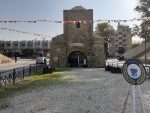 Kyrenia Gate is a gate in the city wall, known as the Venetian Wall, which surrounds the whole of the old town and is remarkably intact. It dates from 1567 and has 11 fortifying bastions equally spaced around it giving it a shape something like a snowflake on a map. The wall was intended to keep out Otterman invaders, but failed miserably in 1570 when the Ottomans broke through and killed 50,000 of the city’s inhabitants. Around the outside of the wall is a wide strip of land like a dry moat.
Kyrenia Gate is a gate in the city wall, known as the Venetian Wall, which surrounds the whole of the old town and is remarkably intact. It dates from 1567 and has 11 fortifying bastions equally spaced around it giving it a shape something like a snowflake on a map. The wall was intended to keep out Otterman invaders, but failed miserably in 1570 when the Ottomans broke through and killed 50,000 of the city’s inhabitants. Around the outside of the wall is a wide strip of land like a dry moat.
The Gate is at a junction with a very wide road almost like a ring road where all the buses stop, but the set-up was a bit vague. There were some people who looked like students, and I asked them where the bus stop for the university was, and they said “Here, just wait and the bus will come”. I suddenly realised that I had no Turkish money and asked the students if I could pay with euros on the bus. They said if I was going to the university it was free.
Different buses kept coming, most of them quite small with destination boards in the front windows. Suddenly a big red bendy bus came and the students all surged forwards, so I assumed that this must be the one. It was standing room only, and was very uncomfortable, with a lot of jerking and jolting. As I was between 50 and 60 years older than everyone else on the bus I have to admit that when a student offered me his seat I accepted it. I suddenly noticed a sign on the door extolling the advantages of the Oyster card, and another one behind the driver saying that there was a £50 fine for travelling without a ticket, giving an Arriva phone number. The truth dawned – this was one of Ken Livingstone’s congestion-causing cyclist-killing ex-London Transport bendy buses, spending its retirement carrying students in Cyprus.
The Near East University (NEU)
The expression Near East is not used in Britain, but is used in some other European countries to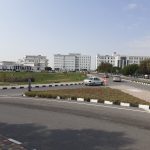 describe what we call the Middle East. The Near East University in Nicosia is an extraordinary place. It was founded in 1988 by a Turkish Cypriot named Suat Günsel, who still owns it. It has over 25,000 students, including many from the Middle East and Africa, plus 1200 academic staff. There are 16 faculties, 4 graduate schools and 15 research centres. Also primary and secondary schools and a kindergarten. The campus covers 98 hectares with a Congress Hall, a huge library, a supercomputer, a hospital, a mosque, a Communications Museum, an Art Museum, and most importantly the Museum of Classical and Sports Cars.
describe what we call the Middle East. The Near East University in Nicosia is an extraordinary place. It was founded in 1988 by a Turkish Cypriot named Suat Günsel, who still owns it. It has over 25,000 students, including many from the Middle East and Africa, plus 1200 academic staff. There are 16 faculties, 4 graduate schools and 15 research centres. Also primary and secondary schools and a kindergarten. The campus covers 98 hectares with a Congress Hall, a huge library, a supercomputer, a hospital, a mosque, a Communications Museum, an Art Museum, and most importantly the Museum of Classical and Sports Cars.
This last item was, of course, the purpose of my visit. For a change I had done my homework and knew whereabouts in the vast campus the museum was situated. From the map in my phone I could follow the movement of the bus as it crawled along the complicated road network, and got off at a point reasonably close to my target.
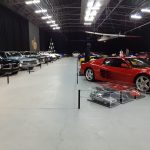 At 20 euros the entry fee to the car museum was a bit over the top, but I had come a long way and I could hardly change my mind about going in. There were 140 cars displayed in two sections, classic cars and modern high-performance sports cars. A considerable number of the classic cars were British, including a Rolls-Royce Silver Shadow, a Jowett Javelin and Riley RM. The sports cars included Ferraris, Mercedes, and other exotica from around the world. I suppose having a display of cars worth millions of pounds in their midst gives the students something to aspire to, but it does seem rather odd in some ways.
At 20 euros the entry fee to the car museum was a bit over the top, but I had come a long way and I could hardly change my mind about going in. There were 140 cars displayed in two sections, classic cars and modern high-performance sports cars. A considerable number of the classic cars were British, including a Rolls-Royce Silver Shadow, a Jowett Javelin and Riley RM. The sports cars included Ferraris, Mercedes, and other exotica from around the world. I suppose having a display of cars worth millions of pounds in their midst gives the students something to aspire to, but it does seem rather odd in some ways.
The next challenge was to find the bus back to the city. It was not too far to walk to the centre of the campus where there were students standing around in front of what appeared to be the headquarters, but it proved to be quite difficult to find anyone who spoke much English, or at any rate, was willing to. In the end I found the best people to ask about the bus were the black African students, who probably spoke English at home,. Buses were coming all the time, and apparently I needed number 2, which turned out to be the same as the one I had come on. It was crowded and I had to stand most of the way.
The impression I got was that the NEU works on a straightforward basis “You give me some money, I will give you an education.” The fees for most courses are about 5000eu. per annum, apart from medicine and dentistry, which are much higher. Looking at the students I got the feeling that they were mainly from fairly well-off families. The NEU is a Muslim institution as might be expected, but there was no sign of any radicalism. Some of the female students wore head-scarves, but I did not see any with veils. Despite the warm weather none of the male students wore shorts, whereas in Britain or the USA most would have done. The only shorts in view were mine, and that is not a particularly pretty sight.
Back at Kyrenia Gate I left the bus and walked through the back streets to the Ledra Street check point, passing some run down workshops in which people were patching up old cars. There was nothing greatly of interest apart from two or three damaged rotary-engined Mazda RX8s, which I suspect would eventually emerge as one vehicle.
After another brief passport check I was back on the Greek side, aiming for the Cyprus Classic Motorcycle Museum, which is also in the back streets not far from the check point. This museum is the property of Andreas Nicolaou
and has about 100 machines on display. Andreas told me his family lived in Famagusta when he was young and they had a collection of 15 motorcycles, mostly British. When the Turks invaded they had to leave in a hurry and could not take the bikes with them. He thinks some of them might have finished up in England years later, bought by dealers who went to Northern Cyprus. Anyway, his family were successful in their new life in the South and he now has a total collection of over 400 bikes.
In the museum I got talking to a man who was in the British army and retired to live in Cyprus. I mentioned that I had been through the border, and he said “What! You’ve been through? I’ve never been!”. It was as if I said I had just been to Syria or Afghanistan. He also said that the U.N. Peacekeeping force along the Green Line was currently made up of British and Argentine soldiers.
The next morning I checked out of the hotel but left the car in the car park. The plan was to have another look round Turkish North Nicosia before driving back to Larnaca. I passed through the Ledra Street checkpoint again and turned immediately left inside the Green Line border and followed it round until I came to the city wall, where there was an area of no-man’s land with an
unoccupied U.N. watchtower in it. This area was rather run down but undergoing a large scale renovation scheme by the local authority and the U.N. From here I followed the city wall round to Kyrenia Gate and crossed over the ‘Ring Road’ into a tidy area of houses and businesses. After a while I came back to the Gate and walked all along the inside of the eastern city wall until I came to the Green Line border with its notices forbidding photographs. Turning right eventually brought me into the enormous bazaar and ultimately to Girne Caddesi which was about 100 yards from the Ledra Street checkpoint.
Before going through the checkpoint I had a cup of gourmet coffee at a street stall run by a man who had lived in Islington for several years. He was not particularly friendly, but his young assistant was, and started chatting to me in excellent English which he said he had taught himself. He said he was Kurdish, with a Turkish passport, and was studying psychology at the NEU. It was clear that he was very intelligent, but seemed to have little idea what the future held for him. I mentioned that I had difficulty in finding anyone who spoke English in the university, and he said “They can’t be bothered to learn”.
Back to Larnaca
After collecting the car from the hotel I set off on the motorway to Larnaca, turning off on the way to look at a place called Aradippou. The Elysso Hotel found a room for me, and I spent the evening walking down to the beach restaurants for a meal.
My return flight to England to England was not until the next evening, so I had most of a day to have another look at Larnaca. It was still my intention to try the electric scooters, so I parked near the Fishing Shelter again and walked down to the ebike hire place, only to find no one there and the bikes chained up. However, as I walked towards the town I came across some ordinary bikes for hire at the kerbside and got one of those for the rest of the day for 5 euros, a good rate for quite a good bike.
It enabled me to have another look at the old town and then go to some of the big shops further out on the main road towards Nicosia. There were a couple of hypermarkets with everything from stuffed toys to generators and workshop machinery, mostly with Chinese brand names unknown to me. Also an enormous HINO, DAF, SSang Yong, Suzuki dealership with vehicles that you would never find in one place in England.
After seven days of almost perfect sunshine in Cyprus it was a bit of an anti-climax as I trudged at midnight through the pouring rain in the near-flooded Long Stay North car park at Gatwick. I could not help feeling slightly envious of those people who would be having breakfast in the Tea for Two in Pathos in a few hours’ time.
